Snow Camp is an unincorporated community in Alamance County, North Carolina, United States.

The Webster Telephone Exchange Building is located in North Omaha, Nebraska. It was designed by the well-known Omaha architect Thomas Rogers Kimball. After the Easter Sunday Tornado of 1913, the building was used as the center of recovery operations. In 1933, American Bell donated the building to the Omaha Urban League.

The Detroit–Columbia Central Office Building is a building located at 52 Selden Street in Midtown Detroit, Michigan. It is also known as the Michigan Bell Telephone Exchange. The building was listed on the National Register of Historic Places in 1997.
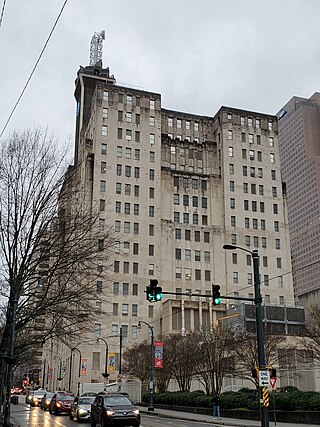
The Southern Bell Telephone Company Building, now known as the AT&T Communications Building, is the main telephone exchange for downtown Atlanta, Georgia. It is located at 51 Peachtree Center Avenue, on the northeast corner of Auburn Avenue.

The Michigan Bell and Western Electric Warehouse is a former commercial warehouse building located at 882 Oakman Boulevard in Detroit, Michigan. It was listed on the National Register of Historic Places in 2009. It is now known as the NSO Bell Building.

John Torrey Windrim was an American architect. His long time chief designer was W. R. Morton Keast.
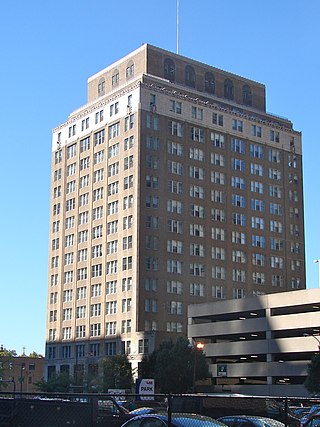
The Bell Telephone Company Building is a historic 17 story skyscraper located at 1835 Arch Street in the Logan Square neighborhood on the edge of downtown Philadelphia, Pennsylvania which was used as a long distance telephone exchange by the Bell Telephone Company. Its construction in 1925 marked the beginning of the era of long distance trunk lines in telephone communication. The building was listed by the National Register of Historic Places in 2000.

Bala Cynwyd Junior High School Complex, is a historic school complex in Bala Cynwyd, Pennsylvania. The complex includes the Bala Cynwyd Middle School, the Cynwyd Elementary School, and the former Lower Merion Academy. The elementary school and middle schools are part of the Lower Merion School District.
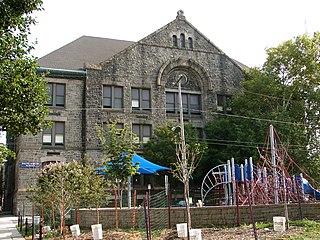
The Bache-Martin Elementary School is a pre-kindergarten to eighth grade school which is located in the Fairmount neighborhood of Philadelphia, Pennsylvania. It is part of the School District of Philadelphia. The school campus comprises two distinct buildings along 22nd Street, both of which were listed on the National Register of Historic Places in 1986.

The George L. Horn School is a historic school building located in the Harrowgate neighborhood of Philadelphia, Pennsylvania, United States.
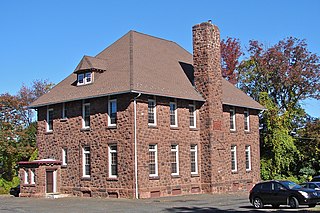
Watson Comly School, also known as Somerton Masonic Hall, is a historic school building located in the Somerton neighborhood of Philadelphia, Pennsylvania.

Charles Schaeffer School is a historic former school building located in the Germantown neighborhood of Philadelphia, Pennsylvania. The building was renovated in 2019 and is now the corporate offices of the Philly Office Retail real estate company.

The Anthony Wayne School is a historic former school building located in the Grays Ferry neighborhood of Philadelphia, Pennsylvania, United States. It was designed by Henry deCoursey Richards and built between 1908 and 1909.

The George W. Childs School is a historic school building which is located in the Point Breeze neighborhood of Philadelphia, Pennsylvania. It was a facility of the School District of Philadelphia.

Franklin Hose Company No. 28, also known as Harmony Engine Company No. 6, is a historic fire station located in the Southwest Center City neighborhood of Philadelphia, Pennsylvania. It was originally built about 1849, and considerably altered with a new front in 1868–1869. It is a four-story, three-bay-wide building measuring 34 by 60 feet. It is constructed of brick, with an ashlar granite-faced first story and a mansard roof. It features round arched window openings and a heavy wood cornice. In February 2010, the building was undergoing renovation.
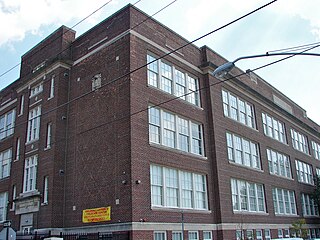
Holmes Junior High School is an historic junior high school building, which is located in the West Philadelphia neighborhood of Philadelphia, Pennsylvania, United States.

Armstrong County Courthouse and Jail is a historic courthouse complex located at Kittanning, Armstrong County, Pennsylvania. The courthouse was built between 1858 and 1860, and is a two-story, brick and stone building measuring 105 feet by 65 feet. It has a hipped roof topped by an octagonal cupola and bell. It features a portico with four Corinthian order columns in Greek Revival style. A three-story rear addition was built in 1951-1953. The jail building was built between 1870 and 1873. It is constructed of stone, brick, and iron, and measures 114 feet by 50 feet, with a 96 feet tall tower. The building once housed 24, 8 foot by 13 foot cells.
The Old Bell Telephone Building is a historic commercial building at 109 North Ash Street in downtown Osceola, Arkansas. It is a two-story flat-roof brick building, built in 1911 to house the town's telephone exchange. The building is three bays wide, with the door in the right bay, with a transom window above. There is an original brass slot for accepting payments between the doorway and the center window. The building was built by R. C. Rose, a local attorney who owned the telephone exchange.
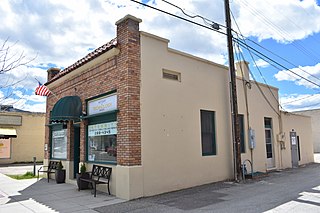
The Mountain States Telephone and Telegraph Company Building in Meridian, Idaho, is a 1-story commercial office constructed of reinforced concrete, stucco, and brick in 1928. The building features a short, modest tile roof above its Main Street entrance, indicating a Spanish Revival design influence. The Main Street exposure is clad with brick veneer, and above the entrance is a corbelled brick frieze band. A masonry garage was added at the rear of the building in 1948. The garage was remodeled in 1998.






















